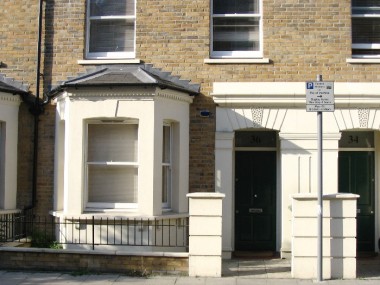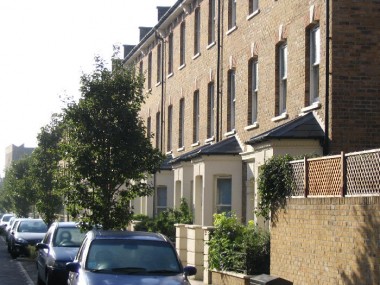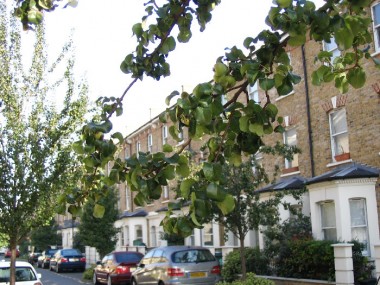|
The information in Sections 2 and 3 below relates to the original Galliard installation of Gledhill SystemateIII thermal stores and Suprema boilers. These are now nearing the end of their lives. If you are thinking about replacing either of them we can recommend MJC Plumbing. They are SE1-based, expert, friendly and efficient. The old thermal store was removed and replaced with a stainless steel one and a new control system all in one day, minimising the disruption to our tenants. It also reduced the heat at the top of the house!Find more information and contact details on their website Zoom247 or call: 02070646777. |
A special page on the heating and hot water system – because it is special!
To understand the central heating in the Galliard-built Marcia Road houses, you need to think in three parts:
You will also need to understand how to manage the system. Read the following sections before jumping to the Problems section.
1. The radiator system
This is completely conventional. Hot water (not the hot water you wash with) is pumped around the radiators. Each radiator has a valve that responds to the room temperature, and a trapped air release vent which may need occasional attention. (See the Problems section below – ‘Radiators are hot at the bottom but cold at the top’.)
2. The boiler
The boiler is located in the kitchen and is a conventional condensing (not combi) boiler.
The original boilers installed were Potterton Suprima models. Here is the Suprima User Guide (pdf 500Kb Right-click and ‘Save As…’ to download) It is quite possible now that the original boiler has been replaced with a more modern one but the principal is the same: it provides heat to the thermal store tank in the cupboard on the top floor. See the next section.
If a Suprima boiler ceases to work properly (they are known for starting to go off for no apparent reason after a few years – usually the control boards need replacing) and you or the landlord are not covered by an annual insurance-type payment plan, we suggest contacting Potterton Customer service to arrange for an engineer to visit. This is likely to cost about the same as having a plumber see to it, the work and parts are guaranteed and you can spread the payments.
3. The hot water storage system
The Gledhill-supplied system is energy-efficient and not complicated, but it needs a special section on this page because it is unusual and – BEWARE – most plumbers do not know how to fix it if it goes wrong.
What makes it special is that the water in the tank in the airing cupboard on the top floor acts as a ‘heat reservoir’ which then heats the radiator water and the hot water for washing. If the heat from the tank in the upstairs cupboard bothers you, see the Problems section below, but after you have read the rest of this.
The water in the tank only travels between the tank and the boiler. When someone turns on a tap for hot water, cold water from the mains is rapidly heated by the hot water in the tank by passing through a ‘heat exchanger’. See the top part of the diagram below. This is great because it means that you get hot water at mains pressure!
It also means that, unlike the systems in most houses, it is not necessary to have a feeder tank in the roof to top up the system as hot water is used, and that the tank is less likely to corrode and flood the house.
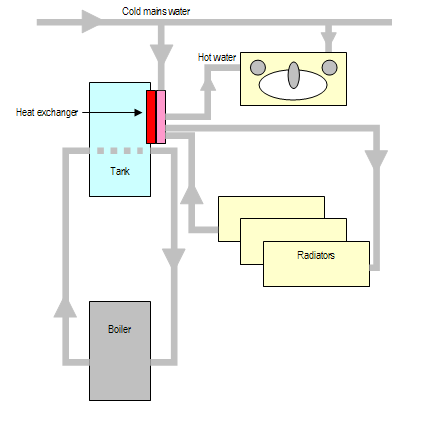
When the temperature of the water in the tank drops (because someone has turned on a hot tap, for example, or the water for the radiators needs heating) the boiler will come on and heat up the water in the tank to maintain it at its working temperature. This is why the boiler sometimes seems to come on when you are not using hot water, and why it is more efficient to have the boiler water temperature turned up high – the boiler has to work less hard, less often.
This is also why it is best to use the gas to heat hot water in the summer, not the electric heating element in the tank, which is there for emergencies when you have no gas.
So far, so good!
What makes the system difficult for most plumbers is the sophisticated electronic control board in the panel on the tank where the timer clock is. This controls three important aspects of the system:
- the temperature of the water in the tank
- the temperature of the hot water for washing
- the temperature of the water going to the radiators
If the control board goes wrong, you will need expert help. If you or your plumber think that there is a problem with the control board Gledhill has a service department called Gledhill Response which can be contacted on 0800 1018365 or see their website). To repeat the warning above – from painful experience – most plumbers do not understand how the parts of the system work together. However, you might like to give Owen Johnson a call to check the system in the first instance.
In addition, here are two Gledhill manuals for the original Systemate system (Right-click and ‘Save As…’ to download):
Systemate Owner’s Handbook (pdf 1.4Mb)
Systemate III technical manual (pdf 2.5Mb)
4. Managing the system
Assuming that the heating system has no problems and is working properly, there are some things that you need to do to manage it efficiently – that is, to get a balance between being comfortable, being environmentally friendly, and not spending too much on your bills.
1) Set the water temperature thermostat on the boiler in the kitchen to ‘high’. That sounds counter-intuitive but the system is designed to work most efficiently that way. If, as a result, the hot water in the taps becomes too hot to be comfortable, it indicates that there may be a fault in the system. (See Problems, below.)
2) To manage the thermostatic radiator valves (TRVs), start off with them all at a mid position, close the room doors and let the heating system run for an hour or two. When you go into the room, if it is then too warm, turn the radiator valve down slightly and, if it is not warm enough, turn it up. You cannot tell if the setting is right by touching the radiator! (The reason is it will either be cool and heating up, or hot and cooling down.) When the room is at the temperature you want, leave the thermostatic valve alone. Note: TRVs do not control the boiler; when the room temperature goes above their setting they reduce the flow of water through the radiator to which they are fitted. A lower setting uses less energy and so will save you money.
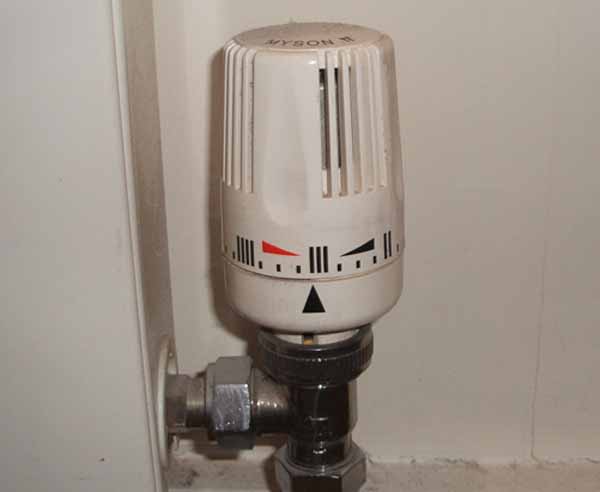
Note: Somewhere in the house there may be a radiator with no adjustable valve. This is a safety feature to prevent the system from overheating.
3) Adjust the room thermostat located on the wall in the hallway. When the temperature in the hallway rises above the temperature the thermostat is set at (a warm 22 degrees in the picture below), it will shut down the heating system, and vice versa. Note, therefore, that if the radiator in the hallway is putting out too much heat, it may ‘fool’ the thermostat into turning off the rest of the system too soon. You will need to experiment to get the thermostat and the radiator settings that suit you.
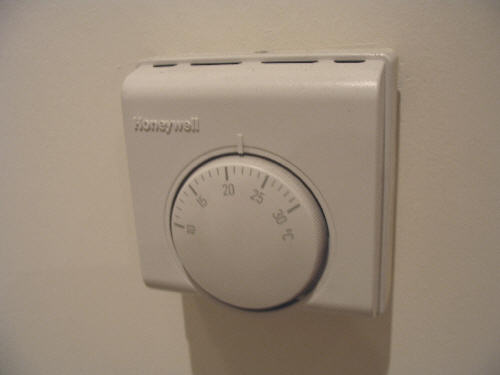
4) Adjust the time control clock on the hot water storage tank in the top floor airing cupboard. Instructions are on the plate underneath the clock. When in an ‘off’ phase, the radiators may still feel hot for some time because they cool slowly. Also in an ‘off’ phase, you may hear the boiler in the kitchen fire up. This is to do with maintaining the temperature in the hot water tank, .(See above for an explanation.)

5) Note: When the timer is in an ‘on’ phase (manual or automatic), the setting of the wall thermostat overrides it. That is, turning the thermostat to a low temperature will turn off the heating, and turning it up will start the heating again. However, when the timer is in an ‘off’ phase, the setting of the thermostat has no effect.
Here is a checklist for the above settings:
1) Hall thermostat set right?
2) Time switch working? (See 2, below)
3) Radiator TRV open?
5. Problems with the heating system
Most of the time, problems are a matter of the above management settings not being right, so use the above checklist first.
However, systems do go wrong. Here are some issues that can happen. Please read and note the disclaimer at the top right hand side of the page!
- Too much heat is coming from the cupboard where the tank is
- The heat comes on or goes off at the wrong time
- No heat or hot water: the whole system is dead
- The hot water is fine, but the radiators are not heating up
- One radiator is cold when the rest are hot
- Radiators are hot at the bottom but cold at the top
- Water for washing is too hot or too cold
- There are gurgling or banging noises coming from the pipes in the house
- The boiler works for a while, then switches itself off



